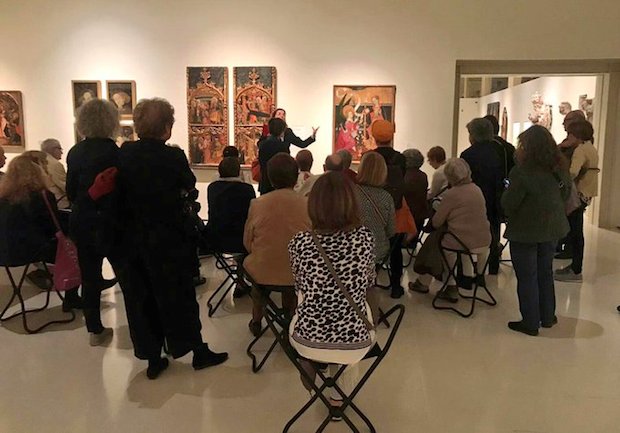Balma Badal

Being a Friend of the Museu Nacional (Amics del Museu Nacional) is a privilege because, among many other things, it gives you the possibility of looking at the museum’s collection from very diverse points of view that, at the same time, allow you to focus on different themes.
The connecting thread of one of the latest visits that we made to the museum’s rooms has allowed us to place the focus of attention on the furniture and the domestic interiors of Gothic art. Accompanied by Mónica Piera Miquel, the president of the Association for Furniture Studies, we observed the furniture, the fabrics and the objects in general use that tell us about the everyday life of a particular segment of society.
The works we observed during the visit made it clear that Gothic art depicted delicately, and in detail, how important and valuable furniture was in the everyday life of society.
Small chests, or amatory caskets
We began the visit observing the first objects that we came to: small chests, or amatory caskets, such as the 15th-century Amatory casket with lady and unicorn. These caskets are normally small rectangular containers that, as their name indicates, men engaged to be married offered as a love gift to their future wives so that they could use them to keep personal effects in. In some cases, these receptacles were used later as reliquaries, and it is thanks to this that so many have survived. In keeping with their purpose – as a gift of betrothal or courtship – amatory caskets were decorated on the outside with scenes of a profane nature, often associated in some way with love, the couple and chivalrous scenes.

The very concept of a casket, a receptacle in which something of value is kept, is associated with women’s virginity. According to the code of courtly love, it is the lady who will decide if she agrees to courtship or not.
Anonymous, Amatory casket with lady and unicorn, 15th century, Wood and bone with metal ornaments and Tafilet leather
The chest
As we continued on our visit to the museum’s rooms an item caught our eye, similar to the casket but larger: the chest. This object – the ancestor of what today we would call suitcases and wardrobes – was used from the time of the earliest nomadic societies up until the 18th century. Indeed, Mónica Piera told us that this use, so constant and enduring, surprises her, because by the 16th and 17th centuries a great variety of items of furniture were being used for very different specific purposes. Nevertheless, clothes and personal effects continued to be kept in a chest.
One possible reason is almost certainly that it made transportation much easier. The things contained in them remained settled at the bottom, did not move and were protected by a lid. Notwithstanding that, there is also a symbolic and emotional reason that explains their prolonged use: many chests were inherited and formed part of the dowry. Many of them were, moreover, so powerfully symbolic that this overshadowed the object’s functional purpose. It was far more important for the chest to identify the person to whom it belonged.

A well-known variation is the bridal chest, such as the Bridal chest with the Annunciation (second quarter of the 16th century) in the Museu Nacional. This type has been more important internationally and has been recognized since the 15th century all over the world.
On these chests the Virgin Mary is often depicted as an allegory of the perfect woman. Their models may vary according to the owner’s social standing, for example in the number of drawers and the richness of the decoration.

Symbolism and multipurpose uses
Apart from caskets and chests, throughout the visit we had the opportunity to study other aspects to do with Gothic domestic interiors.
Our attention was drawn, for example, to the importance attached during the Middle Ages to the fact that a piece of furniture could have different uses: we observed, among others, chests that were used as seats or bed bases, and bureaus that were used for keeping books in as well as for writing.
We were also surprised by the symbolism of the objects and their part in the hierarchical structuring of society, as is the case, for example, with the items that were used to sit on. We saw that the individual seat in the medieval period and up to the 18th century was the element that best indicated social status. Whoever sits differently to the others is unique, special, and has power. It is for this reason that the seat is not expected to be comfortable – symbolically, nobody feels comfortable in a position of responsibility.
- Anonymous, Annunciation, 1410-1430
- Workshop of Pedro García de Benabarre, Birth of the Virgin, c. 1475
With these reflections we come to the end of a visit to the Museu Nacional’s collection that allowed us to observe details that many of us had not noticed on previous visits. It was an interesting discovery!
Relaled links
- The Association for Furniture Studies
- Eva Pascual Miró, L’Art Gòtic a Catalunya. Arts de l’Objecte: El Moble, Enciclopèdia Catalana, Barcelona, 2008. (Catalan)
- Catàleg del moble. Edat mitjana, segles XIV-XI. Fons del Museu Frederic Marés / 6.1 Ajuntament de Barcelona. Digital Format. (Catalan)
Amics del Museu Nacional d'Art de Catalunya















